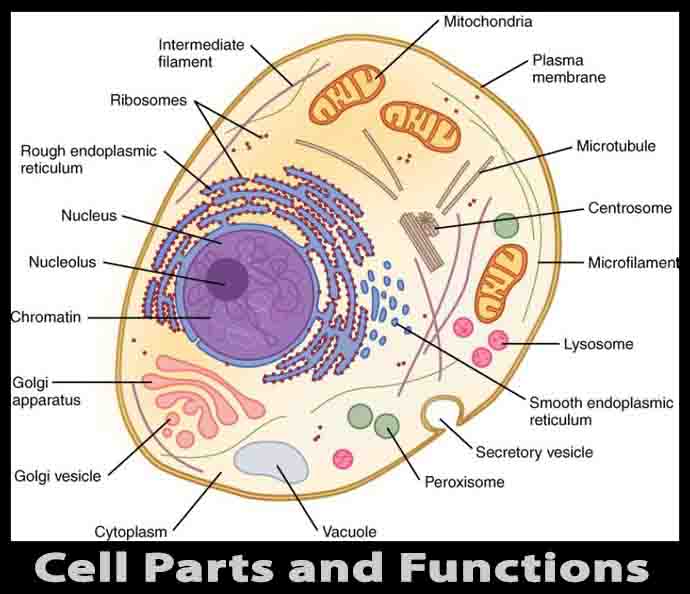Each cell contains specialized subcellular structures adapted to keep it alive. In addition to releasing energy, some of these structures produce proteins, transport substances, and control cellular activity. Organelles are collectively referred to as these structures.
Both plant and animal cells contain organelles, many of which are similar. Plant cells, however, contain some organelles (such as chloroplasts, cell walls, and large vacuoles).
Animal Cell Parts And Their Functions
A cell consists of many parts, each of which plays a vital role in its survival.
The Nucleus
Each cell’s nucleus houses all of its genetic information and functions as its control center. In most cells, all of the DNA molecules reside in a single nucleus. However, some cells have more than one nucleus (such as skeletal muscle cells).
Cell division, growth, protein production, and cell death are all controlled by the nucleus, which protects the DNA of the cell.
Ribosomes
All proteins produced by a cell are also blueprinted in DNA molecules within the nucleus. Plants and animals produce proteins from these blueprints by ribosomes, which read and interpret them. Proteins are produced by ribosomes assembling amino acid sequences according to genetic instructions. Other organelles in the cell fold the polypeptide chains into primary, tertiary, or quaternary 3D structures.
Mitochondria
To power biochemical reactions, cells need energy, and mitochondria release most of that energy. Energy is stored in ATP (adenosine triphosphate), which is produced by mitochondria, the ‘powerhouses’ of cells. All other cell activities are fuelled by ATP molecules, which are the cell’s currency.
Endoplasmic Reticulum (ER)
In a cell, the endoplasmic reticulum is a network of membranes responsible for processing and transporting new materials. A smooth endoplasmic reticulum differs from a rough endoplasmic reticulum.
Ribosomes fill the rough ER, giving it a bumpy or ‘rough’ appearance. Newly synthesized proteins are folded and tagged before being transported throughout the body. A smooth ER does not contain ribosomes, and instead synthesizes hormones and lipids.
Golgi Apparatus
Newly synthesized substances are sent to the Golgi apparatus after leaving the ER. It consists of flat, membrane-bound sacs that package and distribute substances to the outer cell membrane, where they either become part of the lipid bilayer or leave.
Lysosomes
An organelle packed with digestive enzymes, lysosomes are small, spherical organelles. Invading bacteria and viruses as well as old cell parts are broken down and recycled by them. Apoptosis (also known as programmed cell death) is also regulated by lysosomes.
Cytoplasm
A jelly-like substance fills the interior space of cells called cytoplasm. In addition to water, it contains salts, enzymes, and other organic molecules. Many cellular processes (such as protein synthesis and glycolysis) are carried out in the cytoplasm, which surrounds and protects the organelles.
The Cell Membrane (AKA The Plasma Membrane)
Every cell is surrounded by a semipermeable bilayer of phospholipids. As well as separating the interior of the cell from its external environment, the cell membrane controls which substances enter and leave the cell.
Plant Cell Parts And Their Functions
A plant cell contains many of the same organelles as an animal cell, but it also contains a few extra organelles.
Chloroplasts
Photosynthesis occurs in chloroplasts, one of the most important organelles in plant cells. Plants produce food by converting carbon dioxide and water molecules into glucose by using light energy from the sun.
Chlorophyll, the green pigment that gives plants their color, is found in chloroplasts. The chloroplast produces glucose from light energy harvested by chlorophyll. In mitochondria, glucose is broken down to release energy during cellular respiration.
The Cell Wall
Outside of the cell membrane, plant cells have a tough structure called the cell wall, which is mostly made of cellulose. Plant cells have rectangular or box-like shapes due to their cell walls that support and protect them.
The Vacuole
Approximately 90% of the interior space of plant cells is occupied by the vacuole. Its main function is to store information. Mostly water, but also proteins, sugars, and other molecules fill the vacuole, which is filled with cell sap. In addition to maintaining turgor pressure, the vacuole prevents wilting and bursting in the plant cell.

